Prove that ,The bisectors of base angles of a triangle cannot enclose a right angle in any case.
To prove that the bisectors of the base angles of a triangle cannot enclose a right angle, we will follow these steps:
Step 1: Understand the Triangle and its Angles
Let triangle ABC be an isosceles triangle where AB = AC. Let the base angles be ∠ABC = ∠ACB = θ and the vertex angle ∠A = 180° - 2θ.
Hint: Remember that the sum of angles in a triangle is always 180°.
Step 2: Identify the Angle Bisectors
Let the angle bisectors of angles ∠ABC and ∠ACB meet at point D. Since D is on the bisector of ∠ABC, we have:
∠ABD = ∠DBC = θ/2
Similarly, since D is on the bisector of ∠ACB, we have:
∠ACD = ∠DCA = θ/2
Hint: The angle bisector divides the angle into two equal parts.
Step 3: Calculate the Angle Between the Bisectors
Now, we need to find the angle ∠BDA. The angles around point D can be expressed as:
∠BDA = ∠ABD + ∠ACD = θ/2 + θ/2 = θ
Hint: The angles around a point sum up to 360°.
Step 4: Analyze the Value of θ
Since triangle ABC is isosceles, the base angles θ must be less than 90° (if they were equal to or greater than 90°, the triangle would not be a triangle). Therefore, we have:
0 < θ < 90°
Hint: Consider the properties of angles in triangles and the definition of acute, right, and obtuse angles.
Step 5: Conclude About the Angle Between the Bisectors
Since θ is less than 90°, the angle ∠BDA (which is equal to θ) must also be less than 90°. Therefore, the angle between the bisectors of the base angles cannot be a right angle.
Hint: Recall that a right angle is exactly 90°, and since θ < 90°, the angle formed by the bisectors cannot be right.
Conclusion
Thus, we have proved that the bisectors of the base angles of a triangle cannot enclose a right angle in any case.
Let triangle ABC be an isosceles triangle where AB = AC. Let the base angles be ∠ABC = ∠ACB = θ and the vertex angle ∠A = 180° - 2θ.
Let the angle bisectors of angles ∠ABC and ∠ACB meet at point D. Since D is on the bisector of ∠ABC, we have:
∠ABD = ∠DBC = θ/2
Similarly, since D is on the bisector of ∠ACB, we have:
∠ACD = ∠DCA = θ/2
Now, we need to find the angle ∠BDA. The angles around point D can be expressed as:
∠BDA = ∠ABD + ∠ACD = θ/2 + θ/2 = θ
Since triangle ABC is isosceles, the base angles θ must be less than 90° (if they were equal to or greater than 90°, the triangle would not be a triangle). Therefore, we have:
0 < θ < 90°
Since θ is less than 90°, the angle ∠BDA (which is equal to θ) must also be less than 90°. Therefore, the angle between the bisectors of the base angles cannot be a right angle.
Thus, we have proved that the bisectors of the base angles of a triangle cannot enclose a right angle in any case.
Topper's Solved these Questions
Similar Questions
Knowledge Check
- Question 1 - Select One
The bisector of the angles of a parallelogram enclose a
ArectangleBrhombusCsquareDtrapezium
Show that the bisector of vertical angle of an isosceles triangle bisects the base at right angles.
View SolutionProve that the bisectors of two adjacent supplementary angles include a right angle.
View Solution(i) A triangle cannot have more than one right angle.
View SolutionProve that the internal bisectors of the angles of a triangle are concurrent
View SolutionProve that the bisector of the vertical angle of an isosceles triangle bisects the base at right angles.
 View Solution
View SolutionIf the bisectors of the base angles of a triangle enclose an angle of 1350, prove that the triangle is a right triangle.
View SolutionIf the bisectors of the base angles of a triangle enclose an angle of 1350, prove that the triangle is a right triangle.
View Solution

